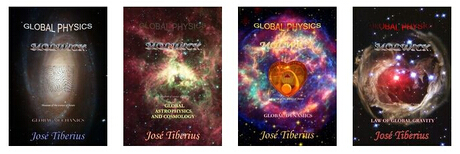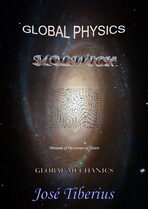1.d) Global theory of unification and everything
The books of Global Physics include topics on:
The principles regarding concepts of matter, gravity, electromagnetism and the mass in Particle physics
The Global Atom and electronic configuration
Astrophysics and Cosmology
The laws in the theory of movement
Experiments of gravitation and energy
The bottom line is to set out the need to change specific concepts and ways of understanding reality. Recognizing the wisdom of Modern Physics, precisely that of General Relativity and Quantum Mechanics, revealing their contradictions –their own, as well as crossed contradictions– and proposing alternative solutions within the scientific method framework.
Global physics is not a Grand Unification Theory or a Theory of Everything because, in addition to unifying the four fundamental forces, it adds others derived from the material support of the previously known forces and energies.
In other words, it is a Global Theory explaining different occurrences, such as those of particle physics, the electronic configuration of the Global Atom, or the expansion of the universe with the same basic principles.

The following is a summary of the books on Global Physics.
-
Among the aspects that stand out the most, we can cite the following:
Description of the structure of matter or Global Aether, that encompasses, worth the redundancy, composition and material support of gravity, kinetic energy, and mass.
Gravity field configuration as LUM Aether (Luminiferous, universal, and mobile)
Unification of gravitational and electromagnetic fields
Unification of gravity force with weak and strong nuclear forces and the new model of the Global Atom
Astrophysics and Global Cosmology
After developing the Global Mechanics to explain the predictions of General Relativity alternatively and beginning to see a theory of everything, it was convenient to study the possible implications on Astrophysics and Cosmology.
The following parts can be highlighted in this book:
New fundamental forces
Principles of Physics affect some aspects of Astronomy like the concepts of a star, black holes, supernova, expansion, and contraction of the universe, dark matter, and dark energy.
A chapter showing that the constant G is constant neither in General Relativity nor in Global Physics, although not precisely the same reasons.
Thoughts on Cosmology about the origin of the universe and the Big Bang Theory
-
This book presents the development of the second group of principles, focusing on the movement of energy and mass on the reticular structure of matter or Global Ether, both with total symmetry or with typical longitudinal curvature of the gravity field and transverse by electromagnetic energy.
In addition, the new nuances to the concepts of mass, movement, and force imply slight modifications of the Laws of Dynamics of Newton.
-
Global Physics is formally presented, naming and discussing physical laws it states, involved physical principals, and the most important and immediate consequences on movement.
Gravitational Law of Equivalence
g = [ c² * h * R / G ] * nThe previous points entail alterations to Newton's Universal Gravitational Law, explaining the components of the atractis causa and the consequences of gravitational energy on movement.
Afterward, there is a discussion of potential, kinetic, and mechanic gravitational energies within the new approach.
Also featured within a post-Newtonian context are the Gigachron experiment and mathematical explanations for Mercury's orbit, gravitational lenses, the redshift of light, and an analysis of the result of the Gravity-Probe-B research.
Scientific experiments in Global Physics -Spanish
Workable physical experiments proposed to demonstrate the incorrectness of the Theory of Relativity, especially the so-called Far Michelson-Morley, and to explain phenomena that General Relativity cannot understand due to its mathematical limitations, curiously called singularities.
This book needs to incorporate a list of the experiments included throughout the books on Global Physics.
* * *
Lastly, the book on the Global Scientific Method tries to understand why so many scientific theories are so weak and to reveal the need for an exact but intuitive science at the same time.
In the case of physics, to optimize brain resources, it would be helpful to eliminate fictitious forces, magical or distant forces such as gravity, negative energies, straight and simultaneously curved lines, and accelerated time. The same applies to confusion between magnitude and measurements that instruments carry out, especially when the mechanisms are sensitive to specific conditions.
* * *

